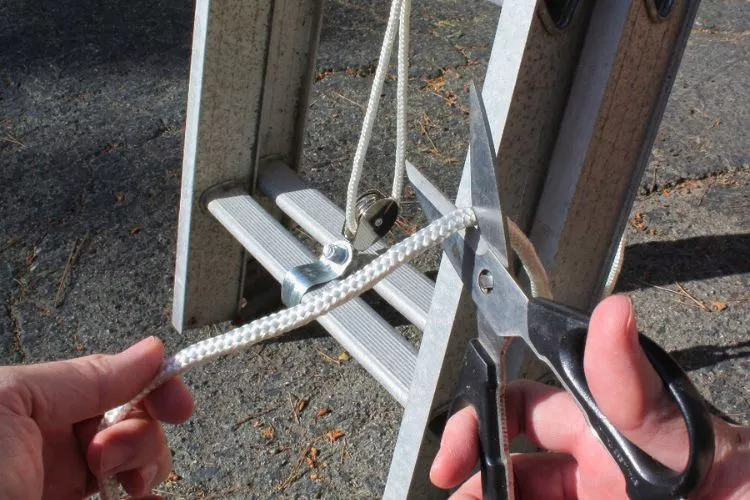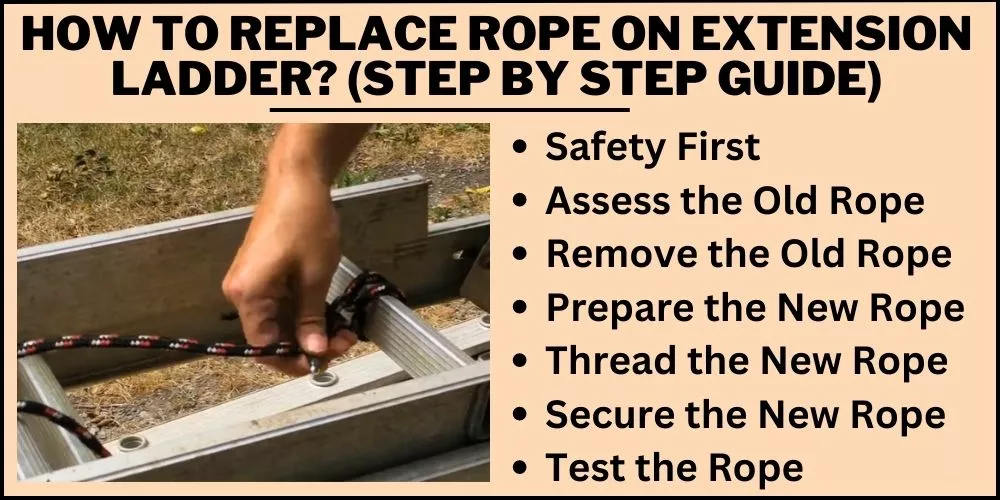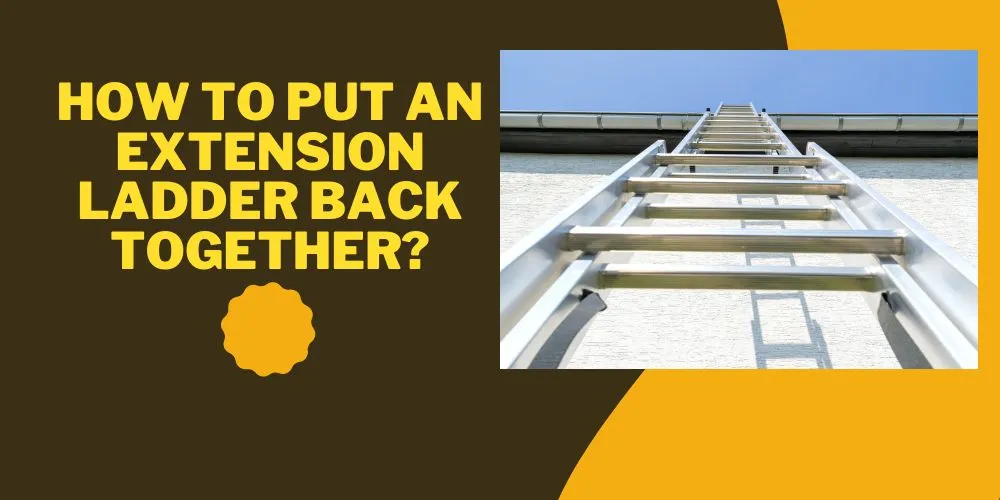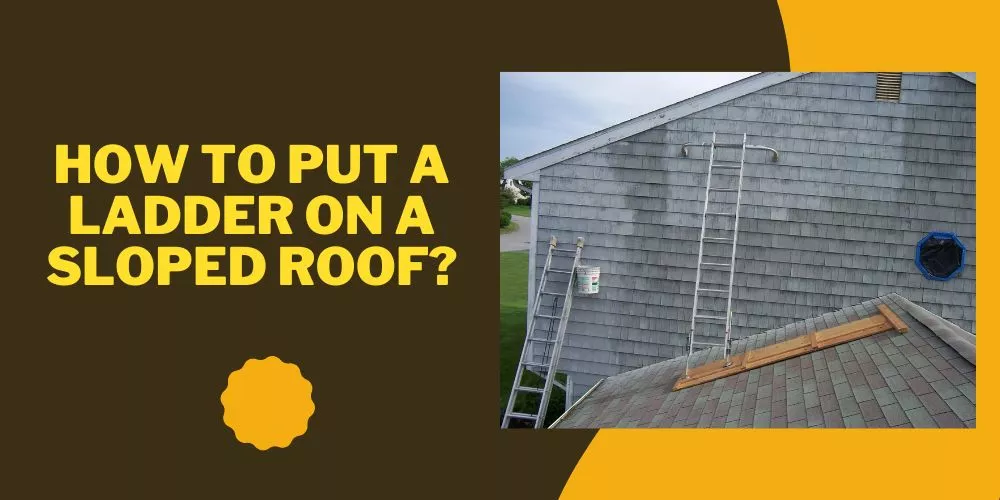Rope replacement is essential to ensure the safety and efficiency of your extension ladder. Frayed, worn-out, or broken ropes can be hazardous and obstruct your work.
This article will provide a comprehensive guide on how to replace rope on extension ladder, allowing you to climb confidently and easily.

With simple instructions and practical tips, learn how to maintain the durability and functionality of your ladder. Let’s begin the transformation to a safer and more reliable climbing experience.
how to replace rope on extension ladder? (An Easy Guide)
When the rope on your extension ladder shows signs of wear or aging, consider replacing it immediately to ensure safety while working.
Here’s a detailed, step-by-step guide on how to replace rope on extension ladder effectively:
Materials Needed:
- A new extension ladder rope, preferably marine-grade rope
- Sharp scissors or a utility knife
- Wide duct tape
- Work gloves

Step by step Guide:
🪜 Safety First
Before proceeding, ensure you wear work gloves to protect your hands from injury. Always place the ladder on a stable, horizontal surface to prevent it from tipping.
🪜 Assess the Old Rope
Inspect the old rope deeply, paying attention to the points where it connects to the ladder’s pulley system and rungs. Understand its tie points and general pathway before starting the replacement process.
🪜 Remove the Old Rope
Commence by detangling the old rope from the ladder’s pulley system, ensuring the ladder is on a flat, non-slip surface for safety. You will be releasing the tension the old rope holds first so brace yourself against any potential movements.
Cut the old rope off the ladder using scissors or a utility knife. Start from the bottom, near the ladder’s base, ensuring the ladder’s sections are fully retracted to prevent unwanted extension.
Slowly progress upwards, carefully detaching the rope from each rung upon which it is secured. Remember where the old rope was fastened — you’ll be attaching the new one on those same points.
🪜 Prepare the New Rope
After the old rope has been safely removed, it’s time to set up your new rope. Obtain a length of new, sturdy rope similar to the old one. When cutting the new rope, aim to make it the same length as the old one to ensure a perfect fit.
However, adding an extra foot or two to the measured length can be beneficial, allowing room for any potential miscalculations or errors. You can always trim excess rope later if it’s too long.
The ends of the new rope can fray easily while threading through the ladder’s pulley and rungs. To prevent this, apply sufficient wide duct tape around each end of the rope.
The adhesive on the duct tape will bind the ends, helping them stay intact during the rigorous threading process. This preparation is essential in ensuring the longevity and reliability of your new ladder rope.
🪜 Thread the New Rope
Now, it’s time to thread the new rope through the ladder’s pulley system, beginning at the bottom of the ladder. Locate the pulley typically stationed with the ladder’s rungs and ensure it moves freely.
Hold the sealed end of the rope and begin by leading it up the side of the ladder, meticulously weaving it through each rung as you progress upward.
For most ladders, the rope goes along the side of the ladder opposite the side with the pulley system, with certain rungs containing guiding notches or hooks where the rope is meant to pass through.
Once you reach the top of the ladder where the pulley is located, thread the rope carefully through the pulley ensuring the rope sits deeply in the groove. Then, guide it back down the other side of the ladder. The rope should now form a path that mirrors the path of the old rope.
🪜 Secure the New Rope
Having threaded the new rope through the ladder and pulley system, it’s time to secure it to ensure the ladder can be extended and retracted smoothly. The method of tying or securing the rope will typically depend on the specific design of your ladder.
To secure the rope, you might find a dedicated cleat, notch, or hook at the bottom of your ladder. If so, pass the rope around or through this point, and make a strong, secure knot.
If your ladder doesn’t feature such a point, simply tie a tight, sturdy knot at the end of the large rope to prevent it from slipping through the rungs or the pulley system. Ensure the knot you tie won’t loosen with repeated ladder use or under tension.
Ensure the tension on the rope is adequate — not too tight to hinder movement, nor too loose to compromise safety or efficiency. This is a crucial step as it directly affects the functionality and safety of your extension ladder.
🪜 Test the Rope
Finally, do a test extension and retraction of the ladder to ensure the rope is correctly installed and working effectively. If the ladder operates smoothly, then you’ve successfully replaced the rope.
Remember, properly maintaining your ladder is critical for your safety. Regularly inspect and replace the rope when it shows signs of serious wear or damage. This will ensure a long life for your ladder and a safe environment.
What size rope for extension ladder?
Choosing the right rope size for your extension ladder is crucial as it significantly impacts its functionality and safety. As per the American Ladder Institute, the rope must have a minimum breaking strength of 560 pounds.
A recommended rope size is often not specified because it depends on the ladder’s design and manufacturer. For instance, a wire cable might be utilized instead of the rope on three-section extension ladders, given that the cable has a minimum 1/8-inch diameter.
When selecting material, you could consider two top-quality ropes: polypropylene and woven nylon, both recognized for their strength. Remember always to follow the specific instructions provided by the manufacturer of your ladder for rope size and type to ensure safe usage.
Werner ladder rope Replacement
If you are looking for Werner ladder rope replacement, you would need their proprietary ‘AC30-2 Extension Ladder Replacement Rope. This rope is designed specifically for Werner’s extension ladders and is preferred because of its compatibility and reliability.
You can purchase this replacement rope from retail websites such as Amazon and Lowe’s.
You can also explore replacement ropes compatible with Werner AC30-2 from other manufacturers on Amazon. However, ensure to check the compatibility of these ropes with your specific Werner ladder model.

If you require instructions on replacing the rope on a Werner ladder, a handy tutorial is available on YouTube.
Please remember to follow every safety instruction the manufacturer indicates and ensure proper installation to avoid accidents.
Some Werner ladders may require a specific size of rope. A YouTube video mentions needing a 3/8″ rope for a Werner extension ladder. Therefore, always verify the size and type of rope required for your specific ladder model.
Remember, routine rope replacement can enhance ladder safety and longevity.
Conclusion:
Replacing the rope on an extension ladder is a straightforward task that ensures its functionality and safety. By carefully removing the old rope, preparing and threading the new one, and securing it properly, you can easily rejuvenate your ladder’s performance.
Choosing the right rope based on your ladder’s make and model is crucial, and following manufacturer’s guidelines is always recommended. With these simple steps, maintaining your extension ladder can become easy, improving its longevity and safety during use.


